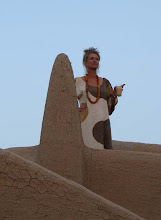The Mitsubishi
The dismantling of my life here has started, if only at snail’s pace. Today I sold the venerable old Mitsubishi Keita and I bought in 2006 from the late ‘Bozo’, may he rest in peace, charming scoundrel that he was. Neither Keita nor I had ever bought a car before, so we were blissfully unaware of small details such as the ‘Carte Grise’, the registration /ownership papers which should always accompany a purchase of a car. Bozo said he ‘acted as agent’ for an absent friend of his and gave us a piece of paper on which it said that this friend was happy to part with his vehicle and that we were now the new owners. There was also a complicated and impressive signature and an official looking stamp which on closer scrutiny turned out to be from a Djenné hardware store with no connection to the transaction whatsoever.
But to start with we never knew
there was a problem with the car and it served us well for several trips to
Bamako where it was loaded up with air conditioners, pillows, and other
necessities for the opening of our mud hotel. We must have been on some sort of
special dispensation and accompanied by a friendly angel guard because no one ever asked us for
any owner ship papers at any of the checkpoints on the road and that is unheard
of...
The Mitsubishi was subsequently used
on innumerable trips to Mopti where it was filled up with beer and other liquid
goodies not available in Djenné. By this time we had realized that we had
bought a dodgy car, probably stolen. But it ran marvellously well and there is
always some way around these problems in Mali. This time the solution came in
the shape of Keita’s brother-in-law who conveniently happened to be the chief
of police in Mopti. All we needed to do
was to call him on the morning of our Mopti trips and he would let the check-point gendarmes know that we were coming. As a thank-you for this favour we always
remembered to bring a couple of sacks of
charcoal for the brother-in-law.
The last time the trusty old
banger was used to great advantage was in December 2014 when I served my stint
as a haulage contractor: it was used for a couple of months to ferry twenty labourers back and forth to the work
site where they were clearing up the debris from a tree planting scheme that
went wrong: see blog.
Now the old Mitsubishi has finally
left me and found a new home with Djenné’s best car mechanic who is aware of
all the problems but who knows the car well and has looked after it for many
years. There were two potential buyers. It turns out that the first ones that
were interested went to see the above car mechanic to ask his opinion on the
vehicle. And he said, helpfully, that
the car is a wreck and not worth buying.
Then he turned up soon afterwards himself with the required money in cash...
And what else? My days are long
and uneventful here now- the most exciting things to report is that the
Southern Red Bishop is back again- is it the same one as last season? He has
become my delightful chubby little friend
which trundles around my garden like an over sized red bumble-bee.
And that is not all: we have a
little chicken that have adopted us. It seems to have no family of its own so
it hangs around the studio and even stays with Petit Bandit in his stable.
And Petit Bandit follows me
around as usual hoping for a piece of bread or a melon peel...



















